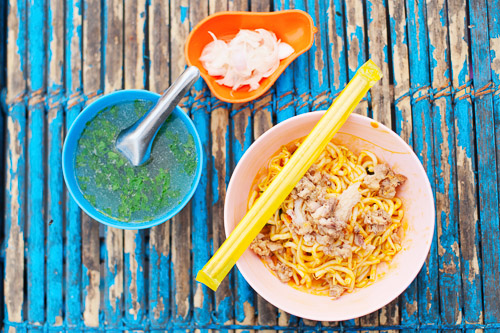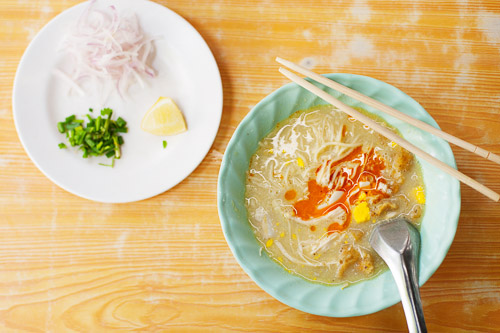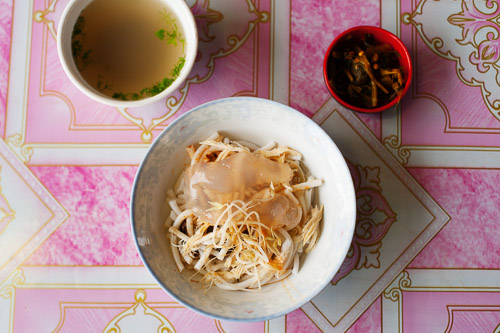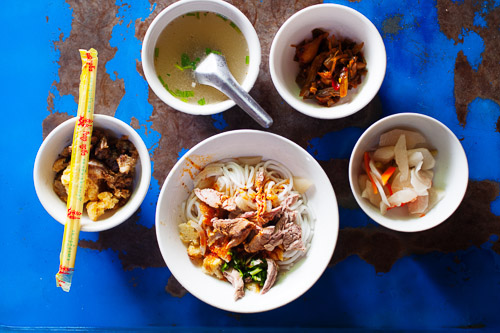The Burmese love their noodles, and in addition to the Chinese-influenced noodle dishes that are found everywhere in Southeast Asia, in Myanmar, you’ll also discover a uniquely indigenous repertoire of noodles. Unlike Thailand's noodle dishes, Myanmar’s have an almost total lack of sugar, and ingredients such as chickpea flour, turmeric oil, deep-fried garlic and toasted sesame provide the dishes with a distinctly savoury profile. Unlike their counterparts in Vietnam, the emphasis is typically on the noodles and seasonings, not meat or herbs, making Burmese noodle dishes generally quite heavy and hearty. The Burmese also have a particular fondness for ‘dry’ noodles, that is, with broth served on the side. And variety of deep-fried crispy garnishes show an appreciation for texture that one doesn’t generally encounter elsewhere.
It can be a bit overwhelming, so in an effort to explain the different varieties, here’s a guide to some of the more ubiquitous noodle dishes that you’ll find only in Myanmar.
'Dry' noodles
Nangyi thoke (နန်းကြီးသုပ်)
This dish takes the form of thick, round rice noodles served with chicken, slices of fish cake, par-boiled bean sprouts and slices of hard-boiled egg. The ingredients are seasoned with a couple tablespoons of chickpea flour, an almost equal amount of MSG, salt, turmeric and/or chili oil, and are served with sides of pickled greens and a bowl of broth. A nearly identical dish, mounti (မုန့်တီ):
omits the eggs and is served with thinly-sliced shallots. The pair are quite possibly the most savoury of Myanmar’s already savoury noodle dishes, and over the course of my most recent trip to Myanmar, became my favourite.
'Soup' noodles
Shan hkuak hswe (ရှမ်းခေါက်ဆွဲ)
Shan State’s most famous dish takes the form of thin, flat rice noodles in a clear, peppery broth with marinated chicken or pork, garnished with toasted sesame and a drizzle of garlic oil, and served with a side of spicy/sour/sweet pickled vegetables. Compared to most other Burmese noodle dishes, it’s relatively bland and simple, but is still satisfying and delicious. A ‘dry’ version, in which the broth is served on the side, is also common.
Mohinga (မုန့်ဟင်းခါး)
Myanmar's unofficial national dish consists of fine, round rice noodles – similar to the Thai khanom jeen -- served in a thick, somewhat herbal fish- and shallot-based broth, often supplemented with the crunchy pith of the banana tree. Optional toppings include sliced hard-boiled egg or akyaw, deep-fried crispy veggies and/or disks of lentil batter.
Ohn-no hkhauk hswe (အုန်းနို့ခေါက်ဆွဲ)
Thought to be the inspiration for the northern Thai khao soi, this Shan dish unites thin, pale wheat noodles, a mild coconut milk-based broth, shredded chicken, slices of hard-boiled egg, a deep-fried crispy garnish and a conservative drizzle of chili oil. Like khao soi, the dish is often served with sides of sliced shallots and lime, although unlike that dish, and unusually for Burmese noodles, no pickled vegetables.
Somewhere In-Between
Tohpu nwe (တိုဟူးနွေး)
Literally 'warm tofu', this dish is similar to shan hkauk hswe, except that the clear broth is replaced by a thick porridge made from chickpea flour. The mixture is supplemented with chunks of marinated chicken or pork, a drizzle of chili oil, and sides of pickled veggies and broth. It’s not an attractive dish, but if you’re a fan of savoury flavours, you won't mind.
Myi shay (မြီးရှေ)
Thick rice noodles (the same as those used in nangyi thoke and mounti) are served with chicken or pork and par-boiled bean sprouts, and brought together via a generous dollop of sticky rice 'glue' -- actually the uncooked batter used to make the noodles. A regional variant, mandalay myi shay (မန္တလေးမြီးရှေ):
is usually served with pork, and comes with sides of deep-fried crispy bits (in this case croutons made from fried bread), pork offal, and two types of pickles. Both versions are seasoned with turmeric and chili oil, and come served with sides of pickled veggies and broth.



















